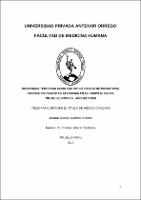Mostrar el registro sencillo del ítem
Menarquía temprana como factor de riesgo de miomatosis uterina en pacientes atendidas en el Hospital Belén Trujillo, entre el año 2017-2018
| dc.contributor.advisor | Alarcón Gutiérrez, Christian | |
| dc.contributor.author | Warthon Amache, Grundy | |
| dc.creator | Warthon Amache, Grundy | |
| dc.date.accessioned | 2019-04-03T19:49:05Z | |
| dc.date.available | 2019-04-03T19:49:05Z | |
| dc.date.issued | 2019 | |
| dc.identifier.uri | https://hdl.handle.net/20.500.12759/4666 | |
| dc.description.abstract | Objetivo: Determinar si la menarquia temprana es factor de riesgo de miomatosis uterina en pacientes atendidas en el Hospital Belén de Trujillo, entre el año 2017 – 2018. Material y Métodos: Se llevó a cabo un estudio de tipo observacional, retrospectivo, analítico, de casos y controles. La muestra estuvo constituida de 273 historias clínicas; donde los casos estuvieron conformados por 91 mujeres con diagnóstico de miomatosis uterina y los controles por 182 mujeres sin el diagnostico en mención atendidas en el Hospital Belén de Trujillo entre el año 2017 – 2018. El análisis estadístico incluyó la prueba Chi cuadrado y odds ratio. Resultados: La edad que predominó fue de 45 a 50 años, con una frecuencia de 48% para los casos y 53% para los controles; en cuanto a la paridad, la nuliparidad respecto a la multiparidad, se halló una asociación estadísticamente significativa, que incrementa 2.69 veces el factor de riesgo para miomatosis uterina (OR 2.69, IC: 1.39-5.21, p=0.002); en los antecedentes familiares comparando a los que no presentan antecedentes familiares, no encontramos asociación estadísticamente significativa (OR=1.60, IC: 0,58-4.45, p=0.362); en el tratamiento hormonal con estrógeno respecto a las que no recibieron dicho tratamiento, se halló una asociación estadísticamente significativa, aumentando 4.21 veces de desarrollar miomatosis uterina (OR 4.21, IC:1.03-17.25, p= 0.031); en la obesidad mórbida no se encontró asociación estadísticamente significativa (OR 3.14, IC: 0.86-11.68, p= 0.068). Así mismo la menarquia temprana muestra una asociación estadísticamente siginificativa que incremente 3.431 veces el factor de riesgo de presentar miomatosis uterina (OR 3.431, IC: 1.608-3.17 y un p=0.01). Conclusiones: La menarquia temprana se halló asociada a presencia de miomatosis uterina en nuestra población de estudio. En el análisis estadístico multivariado, la menarquia temprana se asoció como un factor potencial de riesgo de miomatosis uterina. | es_PE |
| dc.description.abstract | Objective: To determine if early menarche is a risk factor for uterine myomatosis in patients treated at the Belén Hospital of Trujillo, between the year 2017 - 2018. Material and Methods: An observational, retrospective, analytical, case-control study was carried out. The sample consisted of 273 clinical histories; where the cases were made up of 91 women with a diagnosis of uterine myomatosis and controls by 182 women without the diagnosis mentioned in the Bethlehem Hospital of Trujillo between 2017 - 2018. The statistical analysis included the Chi square test Results: The prevailing age was 45 to 50 years, with a frequency of 48% for cases and 53% for controls; in terms of parity, nulliparity with respect to multiparity, a statistically significant association was found, which increases the risk factor for uterine myomatosis 2.69 times (OR 2.69, CI: 1.39-5.21, p = 0.002); in family history, comparing those with no family history, we found no statistically significant association (OR = 1.60, CI: 0.58-4.45, p = 0.362); in the hormonal treatment with estrogen compared to those that did not receive such treatment, a statistically significant association was found, increasing 4.21 times to develop uterine myomatosis (OR 4.21, CI: 1.03-17.25, p = 0.031); in morbid obesity, no statistically significant association was found (OR 3.14, CI: 0.86-11.68, p = 0.068). Likewise, early menarche shows a statistically significant association that increases 3,431 times the risk factor of presenting uterine myomatosis (OR 3.431, CI: 1.608-3.17 and a p = 0.01). Conclusions: Early menarche was found associated to the presence of uterine myomatosis in our study population. In the multivariate statistical analysis, early menarche was associated as a potential risk factor for uterine myomatosis. | en_US |
| dc.description.uri | Tesis | es_PE |
| dc.format | application/pdf | es_PE |
| dc.language.iso | spa | es_PE |
| dc.publisher | Universidad Privada Antenor Orrego - UPAO | es_PE |
| dc.relation.ispartofseries | T_MED.HUMA_2561 | |
| dc.rights | info:eu-repo/semantics/closedAccess | es_PE |
| dc.source | Universidad Privada Antenor Orrego | es_PE |
| dc.source | Repositorio Institucional - UPAO | es_PE |
| dc.subject | Menarquia temprana | es_PE |
| dc.subject | Miomatosis uterina | es_PE |
| dc.title | Menarquía temprana como factor de riesgo de miomatosis uterina en pacientes atendidas en el Hospital Belén Trujillo, entre el año 2017-2018 | es_PE |
| dc.type | info:eu-repo/semantics/bachelorThesis | es_PE |
| thesis.degree.level | Título Profesional | es_PE |
| thesis.degree.grantor | Universidad Privada Antenor Orrego. Facultad de Medicina Humana | es_PE |
| thesis.degree.name | Médico Cirujano | es_PE |
| thesis.degree.discipline | Medicina Humana | es_PE |
Ficheros en el ítem
Este ítem aparece en la(s) siguiente(s) colección(es)
-
Medicina Humana [2762]

